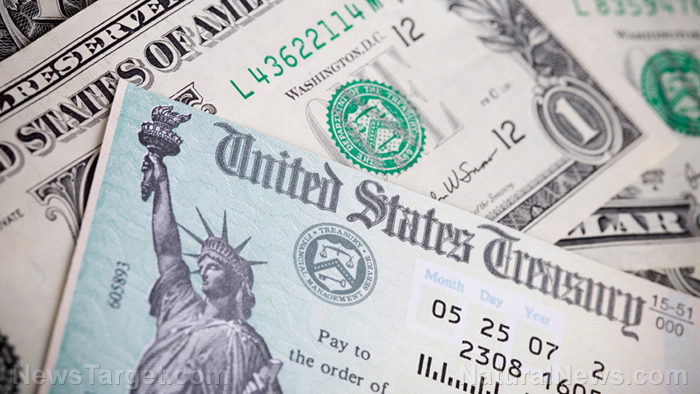Food shortages and inflation continue as “Bidenomics” SPECTACULARLY FAILS
09/07/2023 / By Arsenio Toledo

More food shortages and price hikes are coming before the end of 2023, as President Joe Biden’s economic agenda, dubbed “Bidenomics,” once again puts too much pressure on inflation and food production.
“The economy is in the dump, and no matter how many times the media or President Joe Biden tells us how great we are doing, Americans are going to judge that for themselves by what they see in their wallets, their bank accounts and what the bill is every time they shop for food, appliances, cars, homes or anything else they may need to purchase,” wrote Susan Duclos for All News Pipeline. (Related: Massive government spending is keeping inflation high, warns market expert.)
“Many Americans have been waiting for prices to lower, but even if inflation came to zero – which isn’t even their goal, two percent is – prices will not come down. They just wouldn’t rise for that month,” wrote Duclos. “The only way to lower prices is to see negative inflation, which simply isn’t going to happen.”
The current rate of inflation has slowed down to 4.9 percent in July year-over-year – still more than double the Federal Reserve’s target of two percent – the slowest it has been since last fall. This is also down from the 5.7 percent annual inflation recorded in June.
Of the different food products that saw price increases, frozen vegetables posted the largest increase, costing 17.1 percent more than it did last year. This is followed by margarine, with prices up by 11.3 percent annually.
Other notable food products that saw price increases include cereals and bakery products, which are now seven percent more expensive, and dairy, which is 1.3 percent more expensive.
The ongoing price increases represent a bigger strain on American household budgets, as Americans now consume 13.4 cents on food for each $1 in consumer spending – the second-largest expense for Americans, second only to housing at 34.7 cents per dollar.
“To be sure, the high inflation of the past two-plus years has done lots of economic damage,” noted Mark Zandi, chief economist of Moody’s Analytics. “Due to high inflation, the typical household spent $202 more in July than they did a year ago to buy the same goods and services. And they spent $709 more than they did two years ago.”
The U.S. Department of Agriculture estimates that by the end of the year, food prices will be an average of 5.8 percent higher than in 2022. Next year, food prices will continue rising by an estimated 2.4 percent.
Food shortages in popular food products to continue
To make matters worse for Americans, many food products are expected to experience shortages in the remaining months of the year.
Megan Hageman of Eat This, Not That! warned that five popular food products expected to have troubles with supply are rice, pasta, chocolate, salmon and flour.
The world’s supply of rice has been ravaged since the Western world blocked Russian rice exports since the beginning of the Russian special military operation in Ukraine. Damaging weather in major rice-producing countries like China and Pakistan has also dented global supply.
While pasta is not a core cuisine for most Americans, the global decrease in pasta supply has still affected U.S. households, with the average price of a pound of spaghetti and macaroni rising to $1.47 compared to an average cost of $1.21 per pound last year. In Italy, the pasta shortage got so bad that the country’s government met for crisis talks earlier this year solely to address the issue.
Cocoa – the main ingredient of chocolate – has become a hot commodity in recent months, and current prices are the highest they have been in nearly 12 years. Cocoa is heavily dependent on fertilizer, and because of the drop in global fertilizer supply due to the sanctions on Russian fertilizer exports, global supply has dropped drastically.
The drought in many parts of the U.S. has brought salmon populations into a steep decline this year. To protect the remaining population, California has banned commercial and recreational salmon fishing for the entirety of the 2023 fishing season.
The flour shortage has been ongoing since last year, causing prices to rise by 8.5 percent compared to last year. Analysts warn that Americans will likely continue to feel the effects of this shortage into 2024. Dry conditions in the South and Central U.S. have caused crops of hard red winter and hard red spring wheat to decline, leading to shortages.
Learn more about the true state of the American economy at EconomicRiot.com.
Watch economist Steve Moore explain why Americans will still feel the dire effects of inflation in the coming months.
This video is from the News Clips channel on Brighteon.com.
More related stories:
Fast-food chains under Yum! Brands to go CASHLESS soon: Taco Bell, Pizza Hut, KFC to REJECT cash.
Compilation: Millennials CRUSHED by inflation freak out over soaring cost of living.
Wealthy shoppers now embracing discount stores amid worsening FOOD INFLATION.
Sources include:
Submit a correction >>
Tagged Under:
Bidenomics, big government, Bubble, chaos, Collapse, economic collapse, economic riot, famine, food collapse, food inflation, food shortages, food supply, grocery, hunger, inflation, Joe Biden, market crash, money supply, panic, products, rationing, scarcity, starvation, supply chain
This article may contain statements that reflect the opinion of the author
RECENT NEWS & ARTICLES
COPYRIGHT © 2018 PANIC.NEWS
All content posted on this site is protected under Free Speech. Panic.news is not responsible for content written by contributing authors. The information on this site is provided for educational and entertainment purposes only. It is not intended as a substitute for professional advice of any kind. Panic.news assumes no responsibility for the use or misuse of this material. All trademarks, registered trademarks and service marks mentioned on this site are the property of their respective owners.




















